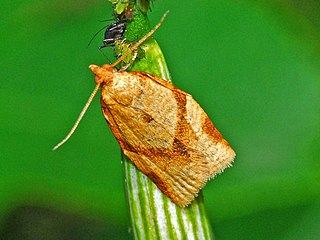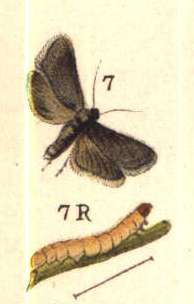
The Tortricidae are a family of moths, commonly known as tortrix moths or leafroller moths, in the order Lepidoptera. This large family has over 11,000 species described, and is the sole member of the superfamily Tortricoidea, although the genus Heliocosma is sometimes placed within this superfamily. Many of these are economically important pests. Olethreutidae is a junior synonym. The typical resting posture is with the wings folded back, producing a rather rounded profile.

Grapholita funebrana, the plum fruit moth or red plum maggot, is a moth of the family Tortricidae. It is found in the Palearctic realm. Like many of its congeners, it is sometimes placed in Cydia.

Crocidosema plebejana, the cotton tipworm, is a tortrix moth, belonging to tribe Eucosmini of subfamily Olethreutinae. It is found today all over the subtropical and tropical regions of the world and even occurs on many oceanic islands – in Polynesia and Saint Helena for example – but has probably been accidentally introduced to much of its current range by humans. In addition, it is also found in some cooler regions, e.g. in Europe except in the east and north; this is probably also not natural, as it was, for example, not recorded in the British Isles before 1900.

Epiblema foenella, the white-foot bell, is a moth of the family Tortricidae.

Clepsis consimilana, the privet tortrix, is a moth of the family Tortricidae.

Grapholita is a large genus of tortrix moths. It belongs to subfamily Olethreutinae, and therein to the tribe Grapholitini, of which it is the type genus.

Grapholita compositella, the clover seed moth, is a moth of the family Tortricidae. It is found from Europe to Asia Minor, Mongolia, China and eastern Russia. It is also present in North America.

Grapholita molesta, the oriental fruit moth or peach moth, is a moth of the family Tortricidae. It is native to China, but was introduced to Japan and North America and is now also found throughout of Europe, Asia and South America and in Hawaii, Morocco, Mauritius, South Africa, Australia and New Zealand

Grapholita pallifrontana is a moth species of the family Tortricidae, subfamily Olethreutinae.

Grapholita internana is a moth of the family Tortricidae. It is found in most of Europe, except the Balkan Peninsula and Fennoscandia.

Grapholita janthinana, the hawthorn leafroller, is a moth of the family Tortricidae. It was described by Philogène Auguste Joseph Duponchel in 1843. It is found in most of Europe, except most of the Balkan Peninsula, Ukraine, Lithuania and Estonia. The habitat consists of hedgerows, gardens and woodland edges.

Grapholita lobarzewskii, the appleseed moth, small fruit tortrix or smaller fruit tortrix moth, is a moth of the family Tortricidae. It was described by Maksymilian Nowicki in 1860. It is found in large parts of Europe, except Norway, Sweden, the Iberian Peninsula and most of the Balkan Peninsula.

Grapholita tenebrosana, the Grapholitha roseticolana, is a moth of the family Tortricidae. It was described by Philogène Auguste Joseph Duponchel in 1843. It is found from most of Europe east to Japan. The habitat consists of woodland, gardens, orchards, parks and scrubs.

Grapholita discretana is a moth of the family Tortricidae. It was described by Maximilian Ferdinand Wocke in 1861. It is found in most of Europe, except Great Britain, Ireland, the Iberian Peninsula and most of the Balkan Peninsula.
Grapholita gypsothicta is a species of moth of the family Tortricidae. It is found in the Democratic Republic of Congo.

Grapholita tristrigana, the three-lined grapholita moth, is a moth of the family Tortricidae. It is found in North America, where it has been recorded from Florida, Georgia, Illinois, Indiana, Maryland, Massachusetts, Missouri, New York, Ohio, Oklahoma, Ontario and Pennsylvania.
Grapholita zariae is a moth of the family Tortricidae. It is found in Nigeria.
Grapholita hymenosa is a moth of the family Tortricidae. It is found in Nigeria.

Grapholita gemmiferana is a species of moth of the family Tortricidae.

Grapholita lunulana is a moth belonging to the family Tortricidae. The species was first described by Michael Denis and Ignaz Schiffermüller in 1775.
















